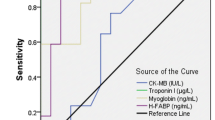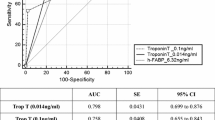Abstract
Heart-type fatty acid-binding protein (H-FABP), a new biochemical marker of sarcolemmal injury due to acute myocardial ischemia, can be used as a tool in early diagnosis and management of patients at high risk. The aim of this study was to determine the early diagnostic value of H-FABP in acute coronary syndrome (within 6–24 h of chest pain) and to compare it with troponin-T (TnT) and creatine kinase–myocardial band (CK-MB) for accuracy. The study consisted of 40 consecutive patients with chest pain admitted to the coronary care unit with the diagnosis of suspected acute coronary syndrome. The patient population consisted of two groups according to the time of admission; the first group (26 patients) included patients admitted within 6 h of chest pain, and the second group (14 patients) included patients admitted within 6–24 h of chest pain. The blood samples for H-FABP, TnT, and CK-MB were obtained at admittance, at the 6th, and at the 24th hours for the first group, and at admittance and at the 24th hours for the second. Statistical analysis was performed among the 26 patients for the first 6 h values, and among all 40 patients for the values obtained within 6–24 h and at the 24th hour. The patients were then divided into groups according to the changes in the electrocardiogram (ECG) and cardiac enzymes as unstable angina pectoris, non-ST elevation myocardial infarction (MI), and ST-elevation MI. Coronary angiography was performed in 38 (95%) patients. Sensitivity of TnT, CK-MB, and H-FABP in the first group (within 6 h of chest pain) were 38%, 76%, and 95% respectively. The sensitivity of H-FABP was significantly higher than TnT (P = 0.014). Sensitivity of TnT, CK-MB, and H-FABP tests in the second time period (within 6–24 h of chest pain) were 100%, 90%, and 91% respectively. In this time period, the sensitivity of TnT was higher than H-FABP, but it was statistically insignificant. At the 24th hour, sensitivity of TnT was 100%, CK-MB 90%, and H-FABP 27.3%, and TnT and CK-MB were more sensitive than H-FABP for the whole group (P = 0.002). In the first group (within 6 h of chest pain) H-FABP positivity was slightly but insignificantly higher in patients with two- and three-vessel disease compared with those with one-vessel disease (60.7% and 33.3%, P = 0.19) and in the same group, patients who underwent primary coronary intervention had a significantly higher H-FABP positivity than others (80%, 32%, P = 0.02). Within 6–24 h of chest pain, H-FABP positivity was 80% in patients with one-vessel disease and 71.4% in patients with two- and three-vessel disease (P = 0.69). Within 6–24 h, positivity of H-FABP reached a peak value of 100% in patients who underwent primary coronary intervention, while H-FABP was positive in 60% of the others (P < 0.001). We conclude that within the 6 h of acute coronary syndrome, H-FABP seems to be a more sensitive biochemical marker than TnT in the early detection of ischemic myocardial necrosis. But after the first 6 h of the onset of chest pain the sensitivity of H-FABP decreases, and this marker should not be used alone in patients admitted 24 h after the onset of chest pain.
Similar content being viewed by others
References
T Nakata A Hoshimoto M Hase K Tsuchihashi K Shimamoto (2003) ArticleTitleHuman heart-type fatty acid-binding protein as an early diagnostic and prognostic marker in acute coronary syndrome Cardiology 99 96–104 Occurrence Handle10.1159/000069726 Occurrence Handle1:CAS:528:DC%2BD3sXktlSisLo%3D Occurrence Handle12711885
JFC Glatz GJV Vusse ML Simoons JA Kragten MP van-Dieijen-Visser WT Hermens (1998) ArticleTitleFatty acid-binding protein and the early detection of acute myocardial infarction Clin Chim Acta 272 87–92 Occurrence Handle10.1016/S0009-8981(97)00255-6 Occurrence Handle1:CAS:528:DyaK1cXhs1GjsLs%3D Occurrence Handle9581860
WM Aartsen MMAL Pelsers WT Hermens JFC Glatz MJAP Daemen JFM Smits (2000) ArticleTitleHeart fatty acid binding protein and cardiac troponin T plasma concentrations as markers for myocardial infarction after coronary artery ligation in mice Eur J Physiol 439 416–422 Occurrence Handle10.1007/s004240050958 Occurrence Handle1:CAS:528:DC%2BD3cXhslWlt7s%3D
A Schreiber B Specht M Pelsers (1998) ArticleTitleRecombinant human heart type fatty acid binding protein as standard immunochemical assays Clin Chem Lab Med 36 283–288 Occurrence Handle10.1515/CCLM.1998.048 Occurrence Handle1:CAS:528:DyaK1cXktVyjur0%3D Occurrence Handle9676384
JFC Glatz GJ Vandervuss (1996) ArticleTitleCellular fatty acid binding proteins. Their function and physiological significance Prog Lipid Res 35 243–282 Occurrence Handle10.1016/S0163-7827(96)00006-9 Occurrence Handle1:STN:280:ByiB38npsF0%3D Occurrence Handle9082452
JA Kragten FA Van Nieuwenhoven MP Van Dieijen-Visser (1996) ArticleTitleDistribution of myoglobin and faty acid binding protein in human cardiac autopsies Clin Chem 42 337–338 Occurrence Handle1:CAS:528:DyaK28XhtFahtLg%3D Occurrence Handle8595739
J Storch EA Thumser (2000) ArticleTitleThe fatty-acid transport function of fatty acid binding proteins Biochim Biophys Acta 1486 28–44 Occurrence Handle1:CAS:528:DC%2BD3cXlt1Snt7w%3D Occurrence Handle10856711
JFC Glatz J Storch (2001) ArticleTitleUnravelling the significance of cellular fatty acid binding proteins Curr Opinion Lipidol 12 267–274 Occurrence Handle10.1097/00041433-200106000-00005 Occurrence Handle1:CAS:528:DC%2BD3MXktlKjtLo%3D
FA Van Nieuwenhaven AH Kleine KWH Wadzig (1995) ArticleTitleDiscrimination between myocardial and skeletal muscle injury by assessment of the plasma ratio of myoglobin over fatty acid binding protein Circulation 92 2848–2854
Y Seino Y Tomita T Takano K Ohbayashi (2004) ArticleTitleOffice Cardiologists cooperative study on whole blood rapid panel tests in patients with suspicious acute myocardial infarction. Comparison between heart-type fatty acid-binding protein and troponin T tests Circ J 68 144–148 Occurrence Handle10.1253/circj.68.144 Occurrence Handle14745150
F Okamoto K Sohmiya Y Ohkaru K Kawamura K Asayama H Kimura S Nishimura H Ishii N Sunahara T Tanaka (2000) ArticleTitleHuman heart-type cytoplasmic fatty acid-binding protein (H-FABP) for the diagnosis of acute myocardial infarction. Clinical evaluation of H-FABP in comparison with myoglobin and creatine kinase isoenzyme MB Clin Chem Lab Med 38 231–238 Occurrence Handle10.1515/CCLM.2000.034 Occurrence Handle1:CAS:528:DC%2BD3cXlt1antLs%3D Occurrence Handle10905760
E Braunwald EM Antman JW Beasley RM Califf MD Cheitlin JS Hochman RH Jones D Kereiakes J Kupersmith TN Levin CJ Pepine JW Schaeffer EE Smith Suffix3rd DE Steward P Theroux JS Alpert KA Eagle DP Faxon V Fuster TJ Gardner G Gregoratos RO Russell SC Smith SuffixJr (2000) ArticleTitleACC/AHA guidelines for the management of patients with unstable angina and non-ST-segment elevation myocardial infarction. A report of the American College of Cardiology/American Heart Association Task Force on Practice Guidelines (Committee on the Management of Patients With Unstable Angina) J Am Coll Cardiol 36 970–1062 Occurrence Handle10.1016/S0735-1097(00)00889-5 Occurrence Handle1:STN:280:DC%2BD3cvlvV2ksg%3D%3D Occurrence Handle10987629
Y Luo D Jiang D Wen J Yang L Li (2004) ArticleTitleChanges in serum interleukin-6 and high-sensitivity C-reactive protein levels in patients with acute coronary syndrome and their responses to simvastatin Heart Vessels 19 257–262 Occurrence Handle10.1007/s00380-004-0776-6 Occurrence Handle15799170
M Yamaoka-Tojo T Tojo T Masuda Y Machida Y Kitano T Kurosawa T Izumi (2003) ArticleTitleC-reactive protein-induced production of interleukin-18 in human endothelial cells: a mechanism of orchestrating cytokine cascade in acute coronary syndrome Heart Vessels 18 183–187 Occurrence Handle10.1007/s00380-003-0719-7 Occurrence Handle14520485
JFC Glatz RJA Paulussen JH Veerkamp (1985) ArticleTitleFatty acid-binding proteins from heart Chem Phys Lipids 38 115–129 Occurrence Handle10.1016/0009-3084(85)90061-1 Occurrence Handle1:CAS:528:DyaL2MXltl2iu74%3D Occurrence Handle4064216
GD Offner P Brecher WB Sawlivich CE Costello RF Troxler (1988) ArticleTitleCharacterization and amino acid sequence of a fatty acid-binding protein from human heart Biochem J 252 191–198 Occurrence Handle1:CAS:528:DyaL1cXls1Gru7c%3D Occurrence Handle3421901
C Sylven E Jansson K Book (1984) ArticleTitleMyoglobin content in human skeletal muscle and myocardium: relation to fiber size and oxidative capacity Cardiovasc Res 18 443–446 Occurrence Handle1:CAS:528:DyaL2cXkvVyis7w%3D Occurrence Handle6744365 Occurrence Handle10.1093/cvr/18.7.443
K Nagao N Hayashi K Kanmatsuse S Kikuchi T Ohuba H Takahashi (2002) ArticleTitleAn early and complete reperfusion strategy for acute myocardial infarction using fibrinolysis and subsequent transluminal therapy: The FAST trial Circ J 66 576–582 Occurrence Handle10.1253/circj.66.576 Occurrence Handle12074277
ME Farkouh PA Smars GS Reeder AR Zinsmeister RW Evans TD Meloy SL Kopecky M Allen TG Allison RJ Gibbons SE Gabriel (1998) ArticleTitleA clinical trial of a chest-pain observation unit for patients with unstable angina: Chest Pain Evaluation in the Emergency Room (CHEER) Investigators N Engl J Med 339 1882–1888 Occurrence Handle10.1056/NEJM199812243392603 Occurrence Handle1:STN:280:DyaK1M%2FmslWmsA%3D%3D Occurrence Handle9862943
K Yoshimoto T Tanaka K Somiya R Tsuji F Okamoto K Kawamura Y Ohkaru K Asayama H Ishii (1995) ArticleTitleHuman heart-type cytoplasmic fatty acid-binding protein as an indicator of acute myocardial infarction Heart Vessels 10 304–309 Occurrence Handle1:STN:280:BymB283lsl0%3D Occurrence Handle8655467
EM Antman E Braunwald (2005) ST-elevation myocardial infarction: pathology, pathophysiology, and clinical features DP Zipes P Libby RO Bonow E Braunwald (Eds) Braunwald's heart disease Elsevier USA Philadephia 1160
Y Seino K Ogata T Takano J Ishii H Hishida H Morita H Takeshita Y Takagi H Sugiyama T Tanaka Y Kitaura (2003) ArticleTitleUse of a whole blood rapid panel test for heart-type fatty acid-binding protein in patients with acute chest pain: comparison with rapid troponin T and myoglobin tests Am J Med 115 185–190 Occurrence Handle10.1016/S0002-9343(03)00325-5 Occurrence Handle1:CAS:528:DC%2BD3sXmsVejtb8%3D Occurrence Handle12935824
A Katrukha A Bereznikova V Filatov T Esakova (1999) ArticleTitleImproved detection of minor ischemic cardiac injury in patients with unstable angina by measurement of Tn I and FABP Clin Chem 45 A139
Author information
Authors and Affiliations
Corresponding author
Rights and permissions
About this article
Cite this article
Ruzgar, O., Bilge, A., Bugra, Z. et al. The use of human heart-type fatty acid-binding protein as an early diagnostic biochemical marker of myocardial necrosis in patients with acute coronary syndrome, and its comparison with troponin-T and creatine kinase–myocardial band. Heart Vessels 21, 309–314 (2006). https://doi.org/10.1007/s00380-006-0908-2
Received:
Accepted:
Published:
Issue Date:
DOI: https://doi.org/10.1007/s00380-006-0908-2




